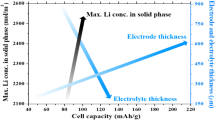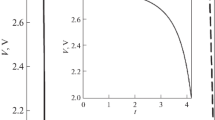Abstract
Among the different energy storage technologies under study, lithium–oxygen batteries are one of the most promising due to their great gravimetric energies and capacities 6–10 times greater than other technologies such as conventional lithium-ion cells. The current study provides a comprehensive understanding of how the anodic (e.g., dendrites) and cathodic designs (e.g., porosity of the carbon cathode and mass fraction of oxygen) affect the discharge characteristics of lithium–oxygen cells. When comparing all changes in dendrite surface, porosity and oxygen restriction, it is concluded that although the changes in porosity and oxygen decrease the performance of the cells, the dendrites led to the greatest decrease in performance of the battery when examining the capacity of the cell. This comprehensive understanding will aid in the design of a cyclable and commercially viable lithium–oxygen battery that could be used for a wide range of energy storage applications.




Similar content being viewed by others
References
P.G. Bruce, S.A. Freunberger, L.J. Hardwick, and J.M. Tarascon: Li–O-2 and Li–S batteries with high energy storage. Nat. Mater. 11, 19 (2012).
J.B. Goodenough and Y. Kim: Challenges for rechargeable Li batteries. Chem. Mater. 22, 587 (2010).
L-X. Yuan, Z-H. Wang, W-X. Zhang, X-L. Hu, J-T. Chen, Y-H. Huang, and J.B. Goodenough: Development and challenges of LiFePO(4) cathode material for lithium-ion batteries. Energy Environ. Sci. 4, 269 (2011).
N.S. Choi, Z.H. Chen, S.A. Freunberger, X.L. Ji, Y.K. Sun, K. Amine, G. Yushin, L.F. Nazar, J. Cho, and P.G. Bruce: Challenges facing lithium batteries and electrical double-layer capacitors. Angew. Chem., Int. Ed. 51, 9994 (2012).
Y-M. Chiang: Building a better battery. Science 330, 1485 (2010).
A.K. Padhi, K.S. Nanjundaswamy, and J.B. Goodenough: Phospho-olivines as positive-electrode materials for rechargeable lithium batteries. J. Electrochem. Soc. 144, 1188 (1997).
Y.C. Lu, B.M. Gallant, D.G. Kwabi, J.R. Harding, R.R. Mitchell, M.S. Whittingham, and Y. Shao-Horn: Lithium–oxygen batteries: Bridging mechanistic understanding and battery performance. Energy Environ. Sci. 6, 750 (2013).
B.M. Gallant, R.R. Mitchell, D.G. Kwabi, J.G. Zhou, L. Zuin, C.V. Thompson, and Y. Shao-Horn: Chemical and morphological changes of Li–O-2 battery electrodes upon cycling. J. Phys. Chem. C 116, 20800 (2012).
Y.C. Lu and Y. Shao-Horn: Probing the reaction kinetics of the charge reactions of nonaqueous Li–O-2 batteries. J. Phys. Chem. Lett. 4, 93 (2013).
K.P.C. Yao, D.G. Kwabi, R.A. Quinlan, A.N. Mansour, A. Grimaud, Y.L. Lee, Y.C. Lu, and Y. Shao-Horn: Thermal stability of Li2O2 and Li2O for Li–air batteries: In situ XRD and XPS studies. J. Electrochem. Soc. 160, A824 (2013).
J. Christensen, P. Albertus, R.S. Sanchez-Carrera, T. Lohmann, B. Kozinsky, R. Liedtke, J. Ahmed, and A. Kojic: A critical review of Li/air batteries. J. Electrochem. Soc. 159, R1 (2012).
J. Hojberg, K.B. Knudsen, J. Hjelm, and T. Vegge: Reactions and SEI formation during charging of Li–O-2 cells. ECS Electrochem. Lett. 4, A63 (2015).
S.Y. Kang, Y.F. Mo, S.P. Ong, and G. Ceder: A facile mechanism for recharging Li2O2 in Li–O-2 batteries. Chem. Mater. 25, 3328 (2013).
F. Ding, W. Xu, G.L. Graff, J. Zhang, M.L. Sushko, X.L. Chen, Y.Y. Shao, M.H. Engelhard, Z.M. Nie, J. Xiao, X.J. Liu, P.V. Sushko, J. Liu, and J.G. Zhang: Dendrite-free lithium deposition via self-healing electrostatic shield mechanism. J. Am. Chem. Soc. 135, 4450 (2013).
X.L. Li: A modeling study of the pore size evolution in lithium–oxygen battery electrodes. J. Electrochem. Soc. 162, A1636 (2015).
C.P. Andersen, H. Hu, G. Qiu, V. Kalra, and Y. Sun: Pore-scale transport resolved model incorporating cathode microstructure and peroxide growth in lithium–air batteries. J. Electrochem. Soc. 162, A1135 (2015).
N. Garcia-Araez and P. Novak: Critical aspects in the development of lithium–air batteries. J. Solid State Electrochem. 17, 1793 (2013).
E.M. Ryan, K.F. Ferris, and A.M. Tartakovsky: Computational modeling of transport limitations in Li–air batteries. J. Electrochem. Soc. 45, 124 (2013).
C. Monroe and J. Newman: Dendrite growth in lithium/polymer systems. J. Electrochem. Soc. 150, A1377 (2003).
J. Shui, J. Okasinski, and C. Chen: In Operando spatiotemporal study of Li2O2 grain growth and its distribution inside operating Li–O2 batteries. ChemSusChem 7, 543 (2014).
J. Tan and E.M. Ryan: Numerical modeling of dendrite growth in a lithium air battery system. J. Electrochem. Soc. 53, 35–43 (2013).
J. Read: Characterization of the lithium/oxygen organic electrolyte battery. J. Electrochem. Soc. 149, A1190 (2002).
X.L. Li and A. Faghri: Optimization of the cathode structure of lithium–air batteries based on a two-dimensional, transient, non-isothermal model. J. Electrochem. Soc. 159, A1747 (2012).
Ansys, Inc.: ANSYS Fluent Fuel Cell Modules Manual, 15th ed. (ANSYS, Inc., Canonsburg, 2013).
A.A. Kulikovsky, J. Divisek, and A.A. Kornyshev: Modeling the cathode compartment of polymer electrolyte fuel cells: Dead and active reaction zones. J. Electrochem. Soc. 146, 3981 (1999).
S. Mazumder and J.V. Cole: Rigorous 3-d mathematical modeling of PEM fuel cells—II. Model predictions with liquid water transport. J. Electrochem. Soc. 150, A1510 (2003).
S. Um, C.Y. Wang, and K.S. Chen: Computational fluid dynamics modeling of proton exchange membrane fuel cells. J. Electrochem. Soc. 147, 4485 (2000).
C. Tran, X.Q. Yang, and D.Y. Qu: Investigation of the gas-diffusion-electrode used as lithium/air cathode in non-aqueous electrolyte and the importance of carbon material porosity. J. Power Sources 195, 2057 (2010).
C. Xia, M. Waletzko, L.M. Chen, K. Peppler, P.J. Klar, and J. Janek: Evolution of Li2O2 growth and its effect on kinetics of Li-O-2 batteries. ACS Appl. Mater. Interfaces 6, 12083 (2014).
F. Orsini, A. Du Pasquier, B. Beaudoin, J.M. Tarascon, M. Trentin, N. Langenhuizen, E. De Beer, and P. Notten: In situ scanning electron microscopy (SEM) observation of interfaces within plastic lithium batteries. J. Power Sources 76, 19 (1998).
M.W. Ayers: Lithium–oxygen batteries—A comprehensive finite element model. In Mechanical and Aerospace Engineering, North Carolina State University: Raleigh, 2015; p. 137.
M.D. Radin and D.J. Siegel: Charge transport in lithium peroxide: Relevance for rechargeable metal–air batteries. Energy Environ. Sci. 6, 2370 (2013).
Author information
Authors and Affiliations
Corresponding author
Rights and permissions
About this article
Cite this article
Ayers, M.W., Huang, HY.S. A comprehensive finite element model for lithium–oxygen batteries. Journal of Materials Research 31, 2728–2735 (2016). https://doi.org/10.1557/jmr.2016.306
Received:
Accepted:
Published:
Issue Date:
DOI: https://doi.org/10.1557/jmr.2016.306




